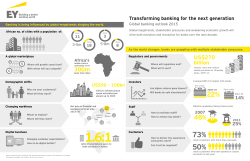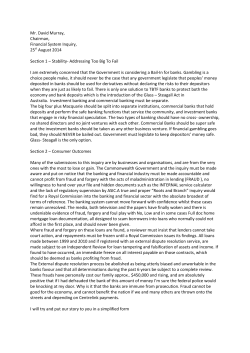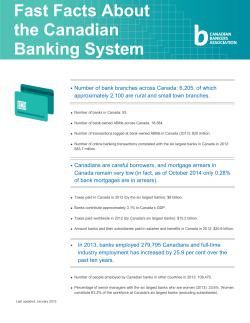
Explaining the Decline in the Number of Banks since the Great
March 2015, EB15-03 Economic Brief Explaining the Decline in the Number of Banks since the Great Recession By Roisin McCord, Edward Simpson Prescott, and Tim Sablik The financial crisis of 2007–08 was a major shock to the U.S. banking sector. From 2007 through 2013, the number of independent commercial banks shrank by 14 percent—more than 800 institutions. Most of this decrease was due to the dwindling number of community banks. While some of this decline was caused by failure, most of it was driven by an unprecedented collapse in new bank entry. The rate of new-bank formation has fallen from an average of about 100 per year since 1990 to an average of about three per year since 2010. If this change persists, it will have a large impact on the composition of the banking sector as well as the flow of credit in the economy. The financial crisis of 2007–08 significantly altered the banking landscape. From 2007 through 2013, the number of commercial banks in the United States fell by more than 800, a 14 percent decline. This drop was highly concentrated among small community banks (banks with less than $50 million in assets), which saw their numbers shrink by 41 percent.1 Although many banks failed during the crisis and its aftermath, this decline was driven largely by a lack of new banks. The number of newly formed banks (called de novo banks) has fallen sharply since 2010. In 2012, there were no de novos, and in 2013 there was only one: Bank of Bird-in-Hand, formed in Lancaster County, Pa., to serve the Amish community. This collapse in new bank entry has no precedent during the past 50 years, and it could have significant economic repercussions. In particular, the decline in new bank entry disproportionately decreases the number of community banks because EB15-03 - Federal Reserve Bank of Richmond most new banks start small. Since small banks have a comparative advantage in lending to small businesses, their declining number could affect the allocation of credit to different sectors in the economy.2 This Economic Brief compares recent events to historical trends and explores some possible explanations for the sharp decline in new community banks. Historical Trends For most of U.S. history, banks were barred from opening branches across state lines, and some states even prohibited intrastate branching. These policies led to a banking system composed largely of thousands of small, independent banks. From 1960 to 1980, there were between 12,000 and 13,000 independent banks in the United States.3 Starting in the 1970s, however, states began relaxing branching restrictions. This process continued throughout the 1980s and early Page 1 1990s, culminating in the Riegle-Neal Interstate Banking and Branching Efficiency Act of 1994, which removed most of the remaining restrictions on interstate branching.4 As a result, the number of banks in the system declined, as weaker or smaller banks were acquired by stronger or larger institutions and banks took advantage of economies of scale. By 2000, the number of independent commercial banks had fallen to less than 7,000. (See Figure 1.) Despite this trend, however, the industry has historically been highly dynamic. Institutions regularly merge or fail, others grow or shrink, and—at least in the past—new banks join the system. Indeed, periods of accelerated bank exits are also typically marked by increased bank entries, as layoffs increase the supply of experienced bankers available to start new institutions.5 At first glance, the past five years do not appear markedly different from previous periods. The decline in the total number of banks could be viewed as a continuation of the trend that began in the 1980s, and exit rates do not differ sharply from previous periods. (See Figure 2.) Indeed, despite the severity of the financial crisis, the exit rate did not significantly change from the pre-crisis period, although more banks did exit due to failure than merger or acquisition. However, a closer examination reveals a striking decline in new bank entry not seen in previous periods: From 2009 through 2013, entry falls to almost zero. A Stark Picture of Bank Entry Breaking down bank entry by type provides an even bleaker picture of the past five years. There are three principle ways a new bank enters the system. First, a savings and loan institution, savings bank, or credit union can become a commercial bank by converting its charter. Second, a bank that was formerly part of a holding company can spin off into an independent entity. Finally, there is a de novo entrant, which is a newly formed bank. The first two types of entrants do not represent “new blood” in the system because a charter conversion is to a large extent a relabeling of an existing institution and a spinoff is a reorganization of existing assets and employees. De novo entries represent wholly new institutions, and focusing on this category provides a starker picture of the collapse in bank entry since 2010. (See Figure 3.) From 2011 through 2013, there were only four de novo banks total, compared to a yearly average of more than 100 from 2002 through 2008. The only period since 1960 that comes close to such a sharp decline was 1993–94, when de novos fell to 28 and Figure 1: Number of Independent Banks in the United States 14,000 12,000 10,000 8,000 6,000 4,000 2,000 1960 1970 1980 1990 2000 2010 Source: Authors’ calculations based on data from the Federal Reserve’s National Information Center Note: The authors treat all commercial bank charters and bank holding companies under a single bank holding company as one independent bank. Page 2 25, respectively. But even that brief decline quickly reversed in subsequent years. In order to get a better sense of the overall impact of the recent drop in de novo entries, two of the authors of this Economic Brief (McCord and Prescott) created a simulation to estimate how the banking landscape would have looked under more typical conditions.6 They find that while there still would have been fewer banks in 2013 than in 2007, the total would have declined by only 269 banks rather than the 836 drop actually observed. They estimate that the weak entry during this period accounts for more than two-thirds of the decline in total commercial banks. They also find that weak entry accounts for a similar proportional decline in the number of community banks. What Accounts for the Lack of Entry? There are a number of factors that correlate with bank entry. Not surprisingly, research has found that entry is more likely in fast-growing, profitable markets.7 One might expect, therefore, that weak economic conditions during the recession of 2007–09 and the subsequent recovery reduced incentives for new banks to enter the system. In a recent working paper, Robert Adams and Jacob Gramlich of the Federal Reserve Board of Governors argue that the decline in new bank entry is due in large part to low bank profitability.8 An important factor in bank profitability is the net interest margin, or the spread between deposit rates and lending rates. The Fed’s policy of keeping the federal funds rate near zero since 2008 has pushed lending rates down, which has kept the net interest margin relatively small. Adams and Gramlich estimate that this low interest rate environment coupled with weak demand for banking services accounts for as much as 80 percent of the decline in bank entry in recent years. However, a literal interpretation of their model would predict that even if the net interest margin and economic conditions recovered to 2006 levels, there still would be almost no new bank entry, suggesting that other factors are also important for explaining the recent decline. Indeed, the net interest margin in the current period may not differ significantly from previous recoveries. Charles Morris and Kristen Regehr of the Kansas City Fed compare net interest income—the revenue from interest on loans after factoring out expenses—in the recent recovery to previous recoveries.9 They find that while net interest income is at historically low Figure 2: Bank Entries and Exits as Percentages of Total Banks 4 2 Percentage 0 2 4 Exits Entries 6 8 1961 1971 1981 1991 2001 2011 Source: Authors’ calculations based on data from the Federal Reserve’s National Information Center Note: Exits include failures and mergers. Entries include newly created banks (de novos), charter conversions, and spinoffs. Page 3 levels, it is similar to net interest income observed during the recovery from the 2001 recession, and it is actually higher than during the recovery from the 1981–82 recession. Even so, entry rates were much higher during each of these earlier recoveries. Banking scholars also have found that new entries are more likely when there are fewer regulatory restrictions.10 After the financial crisis, the number of new banking regulations increased with the passage of legislation such as the Dodd-Frank Act. Such regulations may be particularly burdensome for small banks that are just getting started. Hester Peirce, Ian Robinson, and Thomas Stratmann of George Mason University’s Mercatus Center surveyed community bankers and found that the median compliance staff for respondents doubled from one to two in the three years following enactment of Dodd-Frank.11 Survey respondents cited devoting more time and resources to compliance, and more than 80 percent estimated that such costs had risen more than 5 percent since 2010. However, it is unclear whether compliance costs are a driving factor for the lack of new bank entry. According to data from the Reports on Condition and Income (or “Call Reports”), the ratio of non-interest expenses to assets for banks with less than $1 billion in assets did not change significantly from 2007 through 2013. This finding does not completely rule out the possibility, however, that compliance costs increased. Call Reports do not distinguish between compliance and non-compliance costs, so it is possible that non-compliance costs decreased during this period, masking any increases in compliance costs.12 Some of the costs related to regulatory burdens may be specific to starting a de novo bank. For example, in 2009 the Federal Deposit Insurance Corporation increased the length of time—from three to seven years—during which newly insured depository institutions are subject to higher capital requirements and more frequent examinations. Additionally, anecdotal evidence suggests that the application process for new banks may have become more rigorous following the 2007–09 recession. Organizers of the only de novo bank in 2013 reported that the process was significantly longer and more intensive than it had been in the past.13 Looking Ahead The current decline in commercial banks appears to be driven largely by the complete collapse of new bank entry. If entry remains weak and the Figure 3: Numbers of Newly Created Banks (De Novos) 350 300 250 200 150 100 50 1961 1971 1981 1991 2001 2011 Source: Authors’ calculations based on data from the Federal Reserve’s National Information Center Note: Numbers of newly created banks (de novos) do not include charter conversions or spinoffs. Page 4 exit rate remains constant, the number of banks overall, as well as the number of community banks, will continue to fall. Whether or not the entry rate recovers will depend on what is driving current low levels. If de novos are absent due to the low interest rate environment and weak economic recovery, then entry should increase as the economy improves and the Fed raises interest rates. If regulatory costs are the driving force behind low entry rates, then future entry will depend on how those costs change over time. Roisin McCord is a research associate, Edward Simpson Prescott is a senior economist and vice president, and Tim Sablik is an economics writer in the Research Department at the Federal Reserve Bank of Richmond. Endnotes 1 2 In order to compare bank size across years, size measures reported in this Economic Brief are relative to 2010 dollars. Data in other years are scaled by the change in total bank assets between those years and 2010. For an explanation of the advantages of scaling this way, see McCord, Roisin, and Edward Simpson Prescott, “The Financial Crisis, the Collapse of Bank Entry, and Changes in the Size Distribution of Banks,” Federal Reserve Bank of Richmond Economic Quarterly, First Quarter 2014, vol. 100, no. 1, pp. 23–50. See Berger, Allen N., and Gregory F. Udell, “Small Business Credit Availability and Relationship Lending: The Importance of Bank Organisational Structure,” Economic Journal, February 2002, vol. 112, no. 477, pp. F32–F53. 3 The authors treat all commercial bank charters and bank holding companies under a single bank holding company as one independent bank. For more details, see McCord and Prescott (2014). 4 See Janicki, Hubert P., and Edward Simpson Prescott, “Changes in the Size Distribution of U.S. Banks: 1960–2005,” Federal Reserve Bank of Richmond Economic Quarterly, Fall 2006, vol. 92, no. 4, pp. 291–316; and Jayaratne, Jith, and Philip E. Strahan, “The Benefits of Branching Deregulation,” Federal Reserve Bank of New York Economic Policy Review, December 1997, pp. 13–29. 5 See Keeton, William R., “Are Mergers Responsible for the Surge in New Bank Charters?” Federal Reserve Bank of Kansas City Economic Review, First Quarter 2000, vol. 85, pp. 21–41; and Berger, Allen N., Seth D. Bonime, Lawrence G. Goldberg, and Lawrence J. White, “The Dynamics of Market Entry: The Effects of Mergers and Acquisitions on Entry in the Banking Industry,” Journal of Business, 2004, vol. 77, no. 4, pp. 797–834. 6 See McCord and Prescott (2014). 7 See Dunham, Constance R., “New Banks in New England,” Federal Reserve Bank of Boston New England Economic Review, January/February 1989, pp. 30–41; and Moore, Robert R., and Edward C. Skelton, “New Banks: Why Enter When Others Exit?” Federal Reserve Bank of Dallas Financial Industry Issues, First Quarter 1998, pp. 1–6. 8 Adams, Robert M., and Jacob P. Gramlich, “Where Are All the New Banks? The Role of Regulatory Burden in New Charter Creation,” Federal Reserve Board Finance and Economics Discussion Series No. 2014-113, December 16, 2014. 9 See Morris, Charles S., and Kristen Regehr, “What Explains Low Net Interest Income at Community Banks?” Federal Reserve Bank of Kansas City Economic Review, Second Quarter 2014, pp. 59–87. 10 See Ladenson, Mark L., and Kenneth J. Bombara, “Entry in Commercial Banking, 1962–78,” Journal of Money, Credit and Banking, May 1984, vol. 16, no. 2, pp. 165–174; and Lindley, James T., James A. Verbrugge, James E. McNulty, and Benton E. Gup, “Investment Policy, Financing Policy, and Performance Characteristics of De Novo Savings and Loan Associations,” Journal of Banking and Finance, April 1992, vol. 16, no. 2, pp. 313–330. 11 Peirce, Hester, Ian Robinson, and Thomas Stratmann, “How Are Small Banks Faring Under Dodd-Frank?” Mercatus Center George Mason University Working Paper No. 14-05, February 2014. 12 Beginning in 2008, Call Reports did add some subcategories of expenses, including costs related to legal fees, auditing, consulting, and advisory expenses. Presumably some of these costs are related to costs of complying with regulations. As a percentage of assets, these costs did increase for small banks between 2008 and 2011, but this category of expenses is relatively small, so any increase is unlikely to have a sizable impact on bank profitability. 13 See Peters, Andy, “Amish Bank Charter to Set Standard for Future Applications,” American Banker, December 4, 2013. This article may be photocopied or reprinted in its entirety. Please credit the authors, source, and the Federal Reserve Bank of Richmond, and include the italicized statement below. Views expressed in this article are those of the authors and not necessarily those of the Federal Reserve Bank of Richmond or the Federal Reserve System. FEDERAL RESERVE BANK OF RICHMOND Richmond Baltimore Charlotte Page 5
© Copyright 2025









